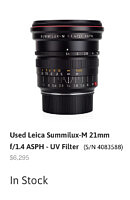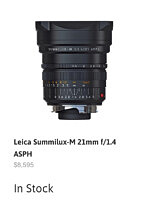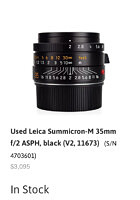- May 3, 2021 at 5:12 pm #27069Jack MacDEstablished Member
 USA, St. Louis, MO and Phoenix, AZJoin Date: Jun 2011Posts: 367Currently using:
USA, St. Louis, MO and Phoenix, AZJoin Date: Jun 2011Posts: 367Currently using:
Leica M, Leica S, Leica CLOffline
That’s an easy choice but not inexpensive.
21mm 1.4.
Lucky for you, the Leica Store Miami has one used as well as new.Attachments:
Jack - May 3, 2021 at 6:19 pm #27072
Thanks for the quick response! These days I find that I end up cropping a lot of my night shots , so I’m using 28 or 35 mm lenses more often than my very wide 15 and 20 mm lenses (where distortion and vignetting can be issues). I have thought about the 21 mm 1.4, but also wonder if the older 35mm Summilux-M f1.4 or the 28 mm Summicron f2, both of which are considerably cheaper, might be a better way to go. Aside from the differences in focal lengths, I’d appreciate thoughts on which of the three is a better lens. Thanks!
Mike - May 4, 2021 at 1:03 am #27073Jack MacDEstablished Member
 USA, St. Louis, MO and Phoenix, AZJoin Date: Jun 2011Posts: 367Currently using:
USA, St. Louis, MO and Phoenix, AZJoin Date: Jun 2011Posts: 367Currently using:
Leica M, Leica S, Leica CLOffline
Mike,
I have not used either the 35 1.4 older model or the 28 2.0 for astrophotography. I don’t believe vignetting is an issue with the 21 but if that’s not your preferred field of view, go with a 35. You have also reduced your cost. What is the issue is what ISO works best on your Sony. If you are willing to shoot at say 3,200 you don’t need 1.4 on the 35mm to “freeze” star movement. Go with a 2.0 but more modern lens. Using the NPF rule, with your Sony you can stop movement as long as you’re exposure is under 6 seconds, right? What I don’t know is what ISO you need for that 6 seconds, unless you are exposure stacking. Of course if you want star trails, you can do low ISO and as long an exposure as you wish.
JackAttachments:
Jack - May 16, 2025 at 2:24 am #44471
This is a fascinating lens! The wide aperture combined with the fast speed promises incredible light gathering capabilities, perfect for capturing faint celestial objects. I’m curious about its performance in mitigating coma and astigmatism, which are critical factors when shooting at such wide angles. Hope someone shares their experiences! Reminds me of the Dinosaur Game.
Try Eggy Car now – go fast, win big, have fun! - July 22, 2025 at 2:15 am #45773
That 21mm 1.4 lens is a fantastic choice, albeit a bit pricey. Think of it as leveling up your photography game! It’s like finally unlocking that powerful weapon in your favorite io games. Good news! The Leica Store Miami has both used and new versions available.
You must be logged in to reply to this topic.



